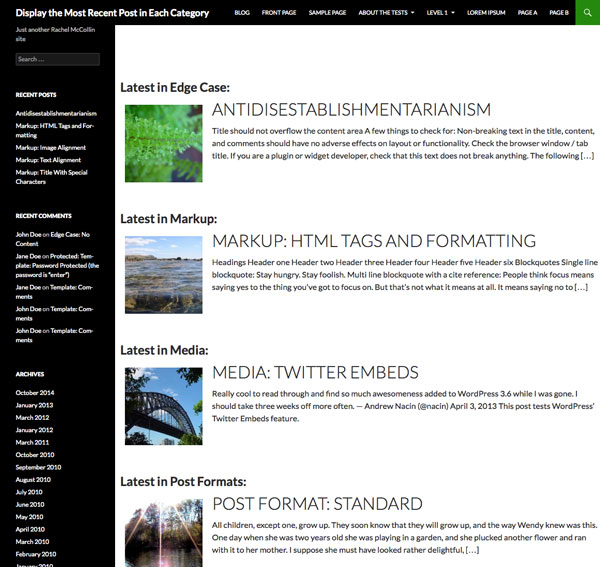默认情况下,您的 wordpress 主博客页面按日期降序显示您最近的帖子。但是,如果您在网站上使用类别,并且您的读者想要查看每个类别中的新内容,您可能希望您的博客页面看起来有所不同。
在本教程中,我将向您展示如何做到这一点。我将演示如何:
要学习本教程,您需要:
第一步是设置主题。我将创建“二十四”主题的子主题,仅包含两个文件:style.css 和 index.php。
这是我的样式表:
/*
Theme Name: Display the Most Recent Post in Each Category
Theme URI: http://code.tutsplus.com/tutorials/display-the-most-recent-post-in-each-category--cms-22677
Version: 1.0.0
Description: Theme to accompany tutorial on displaying the most recent post fort each term in a taxonomy for Tutsplus, at http://bitly.com/14cm0yb
Author: Rachel McCollin
Author URI: http://rachelmccollin.co.uk
License: GPL-3.0+
License URI: http://www.gnu.org/licenses/gpl-3.0.html
Domain Path: /lang
Text Domain: tutsplus
Template: twentyfourteen
*/
@import url('../twentyfourteen/style.css');
我稍后会返回此文件来添加样式,但现在 WordPress 只需要识别子主题即可。
由于我希望我的主博客页面显示每个类别中的最新帖子,因此我将在我的子主题中创建一个新的 index.php 文件。
首先,我将复制 24 中的 index.php 文件,并编辑掉循环和其他内容,使其看起来像这样:
<?php
/**
* The main template file.
*
* Based on the `index.php` file from TwentyFourteen, with an edited version of the `content.php` include file from that theme included here.
*/
?>
<?php get_header(); ?>
<div id="main-content" class="main-content">
<?php
if ( is_front_page() && twentyfourteen_has_featured_posts() ) {
// Include the featured content template.
get_template_part( 'featured-content' );
}
?>
<div id="primary" class="content-area">
<div id="content" class="site-content" role="main">
</div>
</div>
<?php get_sidebar( 'content' ); ?>
</div>
<?php get_sidebar(); ?>
<?php get_footer(); ?>
第一步是确定博客中的类别。紧接着打开 <div id="content"> 标签,添加以下内容:
<div class="code" style="position:relative; padding:0px; margin:0px;"><pre class="brush:php;toolbal:false;"><?php
$categories = get_categories();
foreach ( $categories as $category ) {
}
?>
</pre> 函数来获取博客中的类别列表。默认情况下,这将按字母顺序获取,并且不会包含任何空类别。这对我有用,所以我不会添加任何额外的参数。
然后我使用 foreach ( $categories as $category ) {} 告诉 WordPress 依次运行每个类别并运行大括号内的代码。下一步将创建一个针对每个类别运行的查询。
现在您需要定义查询的参数。在大括号内添加以下内容:
$args = array(
'cat' => $category->term_id,
'post_type' => 'post',
'posts_per_page' => '1',
);
这只会获取当前类别中的一篇帖子。
接下来,使用 WP_Query 类插入查询:
$query = new WP_Query( $args );
if ( $query->have_posts() ) { ?>
<section class="<?php echo $category->name; ?> listing">
<h2>Latest in <?php echo $category->name; ?>:</h2>
<?php while ( $query->have_posts() ) {
$query->the_post();
?>
<article id="post-<?php the_ID(); ?>" <?php post_class( 'category-listing' ); ?>>
<?php if ( has_post_thumbnail() ) { ?>
<a href="<?php the_permalink(); ?>">
<?php the_post_thumbnail( 'thumbnail' ); ?>
</a>
<?php } ?>
<h3 class="entry-title">
<a href="<?php the_permalink(); ?>">
<?php the_title(); ?>
</a>
</h3>
<?php the_excerpt( __( 'Continue Reading <span class="meta-nav">→</span>', 'twentyfourteen' ) ); ?>
</article>
<?php } // end while ?>
</section>
<?php } // end if
// Use reset to restore original query.
wp_reset_postdata();
这将输出每篇文章的特色图片、标题和摘录,并且每一个都包含在一个链接中。
让我们看看现在的样子:

如您所见,存在问题。我的页面显示每个类别中的最新帖子,但它是重复的帖子,因为有时一个帖子会是多个类别中的最新帖子。让我们解决这个问题。
在添加 get_categories() 函数的行上方,添加以下行:
$do_not_duplicate = array();
这会创建一个名为 $do_not_duplicate 的空数组,我们将用它来存储每个帖子输出的 ID,然后检查稍后查询的任何帖子的 ID 是否在其中该数组。
接下来,在查询选项下方添加一个新行,因此前两行如下所示:
<?php while ( $query->have_posts() ) {
$query->the_post();
$do_not_duplicate[] = $post->ID;
?>
这会将当前帖子的 ID 添加到 $do_not_duplicate 数组。
最后,向查询参数添加一个新参数,以避免输出此数组中的任何帖子。您的论点现在如下所示:
$args = array(
'cat' => $category->term_id,
'post_type' => 'post',
'posts_per_page' => '1',
'post__not_in' => $do_not_duplicate
);
这使用 'post__not_in' 参数来查找帖子 ID 数组。
保存您的 index.php 文件并再次查看您的博客页面:

这样更好了!现在您的帖子不再重复。
目前,内容有点分散,特色图片位于帖子标题和摘录上方。让我们添加一些样式以使图像向左浮动。
在主题的 style.css 文件中,添加以下内容:
.listing h2 {
margin-left: 10px;
}
.category-listing img {
float: left;
margin: 10px 2%;
}
.category-listing .entry-title {
clear: none;
}
现在内容更适合页面并且布局更好:

您可以调整此技术以处理不同的内容类型或分类法。例如:
get_categories() 替换为 get_terms() 并更改 'cat' 查询参数来查找分类术语。'post_type' => 'post' 参数您的查询参数与您的帖子类型。foreach 语句来运行多个循环。single.php 页面,以便在帖子内容之后显示每个类别中最新帖子的链接。如果执行此操作,您需要将当前显示页面的 ID 添加到 $do_not_duplicate 数组中。有时,以其他方式(而不是简单地按时间顺序)显示博客上的最新帖子会很有帮助。在这里,我演示了一种技术,用于显示博客上每个类别中的最新帖子,确保帖子在多个类别中不会重复。
以上就是每个类别显示最新的帖子的详细内容,更多请关注php中文网其它相关文章!

每个人都需要一台速度更快、更稳定的 PC。随着时间的推移,垃圾文件、旧注册表数据和不必要的后台进程会占用资源并降低性能。幸运的是,许多工具可以让 Windows 保持平稳运行。




Copyright 2014-2025 https://www.php.cn/ All Rights Reserved | php.cn | 湘ICP备2023035733号